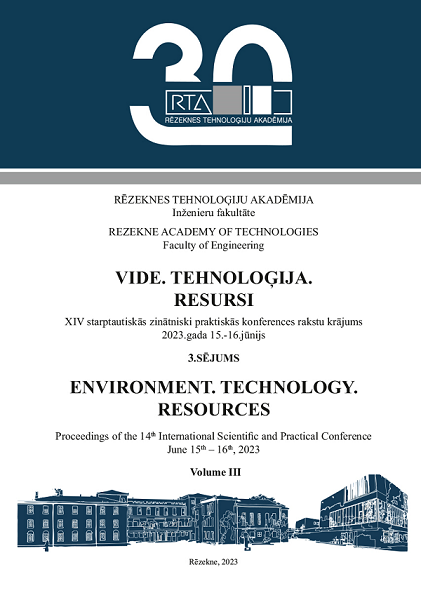THERMAL CHARACTERISTICS OF MATERIALS IN MODELLING OF WELDING PROCESSES
DOI:
https://doi.org/10.17770/etr2023vol3.7202Keywords:
thermal characteristic, modelling, welding processAbstract
The application of welding processes during manufacturing of metallic products result in changes of the properties of the base materials. Process simulation enables evaluation of the effect of heat application in proximity to the weld seam. The availability and use of input data, relevant for the specific material, is essential for the reliability of the results. The thermal characteristics of the materials, required for the heat modelling were identified. Their dependency on the material temperature was investigated and the formulas were presented. Particular values were found in existingdata sources, for specific structural steels, stainless steels, nickel and titanium alloys. The values of the thermal characteristics were represented and in graphical and tabulated formats, facilitating direct implementation in calculations, assessment of variation trends and applicability for specific purposes.
References
International Organization for Standardization Technical Committee 176, Quality management systems — Fundamentals and vocabulary, ISO 9000, 2015.
International Organization for Standardization Technical Committee 44, Quality requirements for fusion welding of metallic materials — Part 2: Comprehensive quality requirements, ISO 3834-2, 2021.
European Committee for Standardization Technical Committee 121, EN 1011-1, Welding. Recommendations for welding of metallic materials. General guidance for arc welding, 2009.
European Committee for Standardization Technical Committee 121, EN 1011-2, Welding. Recommendations for welding of metallic materials. Arc welding of ferritic steels, 2001.
Swedish Steel AB, 299 Welding of Strenx. Advanced High Strength Steels. V1, 2015, p 7.
Stahlinstitut VDEh, Stahl-Eisen-Werkstoffblatt 088 Beiblatt 2: Schweißgeeignete Feinkornbaustähle - Richtlinien für die Verarbeitung, besonders für das Schmelzschweißen; Ermittlung der Abkühlzeit t8/5 zur Kennzeichnung von Schweißtemperaturzyklen.
International Organization for Standardization Technical Committee 44, Numerical welding simulation — Execution and documentation, ISO/TS 18166, 216.
S. Afkhami, V. Javaheri, M.Amraei, T. Skriko, H.Piili, X.L.Zhao, T.Björk, Thermomechanical simulation of the heat-affected zones in welded ultra-high strength steels: Microstructure and mechanical properties, Materials & Design 213, 2022, https://doi.org/10.1016/j.matdes.2021.110336
P. H. G. Dornelas, F.W.C. Farias, V.H.P.M. Oliveira, D.O. Moraes, P. Z. Júnior and J. P. Filho, FEM-thermodynamic simulation methodology to predict the influence of t 8/5 on the coarse grain heat-affected zone of a Cr-Mo low-alloy
steel pipe 60, Journal of Manufacturing Processes, 2020, pp 520–529, https://doi.org/10.1016/j.jmapro.2020.10.082
P. H. G. Dornelas, J. C. P. Filho, V. H. P. M. Oliveira, D. O. Moraes and P. Z. Junior, Studying the influence of the interpass temperature on the heat-affected zone of an API 5L X65 steel welded pipe joint through computational and physical simulations, International Journal of Pressure Vessels and Piping 194, 2021, https://doi.org/10.1016/j.ijpvp.2021.104548
D. Rosenthal, Mathematical theory of heat distribution during welding and cutting, Welding Journal 20, 1941, pp 220–234.
D. Radaj, Heat effects of welding: temperature field, residual stress, distortion, Springer, 1992.
J. Goldak, M. Bibby, J. Moore, R. House, B. Patel, Computer modeling of heat flow in welds, Metall Trans B 17 (3), 1986, pp 587–600, https://doi.org/10.1007/BF02670226
A. Lecoanet and D. G. Ivey and H. Henein, Simulation of the Temperature Profile During Welding with COMSOL Multiphysics® Software Using Rosenthal’s Approach, [Online]. Available: https://www.comsol.com/paper/simulation-of-the-temperature-profile-during-welding-with-comsol-multiphysics-so-19689 [Accessed: Mar. 19, 2023].
E. Nart and Y. Celik, A practical approach for simulating submerged arc welding process using FE method, Journal of Constructional Steel Research 84, 2013.
M. Tongov, Heat Source for TIG welding modelling, Environment Technology Resources Proceedings of the International Scientific and Practical Conference 3:348-356, https://doi.org/10.17770/etr2021vol3.6601
Elsevier B.V., Thermal Conductivity Coefficient, [Online].Available: https://www.sciencedirect.com/topics/engineering/thermal-conductivity-coefficient
Y. Xing, W. Wang and H. Al Azzani, Assessment of thermal properties of various types of high-strength steels at elevated temperatures, Fire Safety Journal 122, 2021, https://doi.org/10.1016/j.firesaf.2021.103348
European Committee for Standardization, EN 1993-1-2: Eurocode 3: Design of steel structures - Part 1-2: General rules - Structural fire design, 2005, pp 23-26.
American Society of Civil Engineers, ASCE 1992: Structural fire protection, ASCE committee on fire protection manual 78, 1992.
ESI Group, SYSWELD - User guide 2020.5,[Online] Available: https://myesi.esi-group.com/downloads/software-documentation/sysweld-2020.5-user-guide-visual-weld-16.0-users-guide-online
COMSOL AB, Heat transfer module user’s guide, Internal material properties library, 2018. [Online].Available: https://doc.comsol.com/5.4/doc/com.comsol.help.heat/HeatTransferModuleUsersGuide.pdf [Accessed: Mar. 19, 2023].
National Institute of Advanced Industrial Science and Technology AIST Japan, Thermophysical properties database system, [Online].Available:
https://tpds.db.aist.go.jp/tpds-web/index.aspx [Accessed Mar. 20, 2023].
National Technical University KhPI, European steel and alloy grades, [Online].Available: http://www.steelnumber.com/en/steel_composition_eu.php, [Accessed Mar. 20, 2023].
National Center for Forensic Science of University of Central Florida, Material Thermal Properties Database, [Online].Available: https://ncfs.ucf.edu/burn_db/Thermal_Properties/material_thermal.html, [Accessed Mar. 20, 2023].
Slovenian Steel GroupSIJ Metal Ravne, Alphabetical Steel Index, [Online].Available: https://steelselector.sij.si/html/steel_index.html, [Accessed Mar. 20, 2023].
Iron Boar Labs Ltd, MakeItFrom.com database, [Online].Available: https://www.makeitfrom.com/, [Accessed Mar. 20, 2023].
World Material, www.theworldmaterial.com, [Online].Available: https://www.theworldmaterial.com/, [Accessed Mar. 20, 2023].
MatWeb, LLC, Material Property Data, [Online].Available: https://www.matweb.com/search/CompositionSearch.aspx [Accessed Mar. 20, 2023].
Steel Grades, Physical Properties of steel grade 1.4301 [Online].Available: 1.4301 Chemical composition, 1.4301 Properties, 1.4301 Datasheet, France AFNOR 1.4301 (steel-grades.com) [Accessed Mar. 20, 2023].



